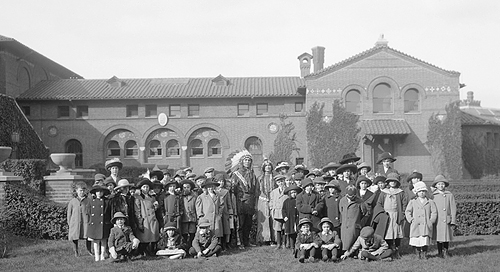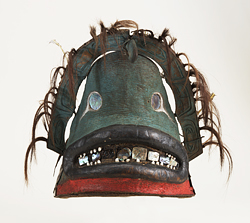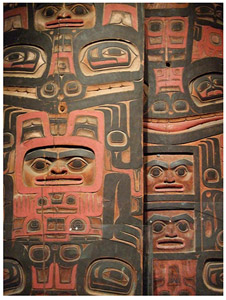| Louis V Shotridge |
Louis Shotridge attended high school at the Presbyterian Mission School in neighboring Haines, Alaska. Haines was a newly established Christian town at Portage Cove on Lynn Canal. The School was a place where Indians “could speedily learn the white man’s ways and Christian habits and where their children could be educated as Boston men and women (Young 1927:210). There, Shotridge met his intended wife Florence “Suzie�? Scundoo (Kaatxwaantsex), the daughter of a high-ranking shaman of the Mountain house, Lukaax.ádi clan of Chilkoot. After four years of schooling she was an accomplished pianist and singer (Smith 1912). The match had been arranged when Louis and Florence were children and they were married on December 25, 1902 (Dauenhauer and Dauenhauer 2003:166). Louis inherited the title of housemaster of the Killer Whale Fin House in his early twenties (Milburn 1986:60). In 1905, Governor John G. Brady selected Florence to represent her people at the Alaskan exhibit at the Lewis and Clark Centennial Exposition in Portland, Oregon. Florence demonstrated Chilkat weaving while Louis explained about textile dyes and masks showing Tlingit facial painting. At the Centennial, George Gustav Heye (the east coast collector whose collection is now the centerpiece of the National Museum of the American Indian) introduced the young couple to George Byron Gordon, Curator of Ethnology at the University of Pennsylvania Museum (Cole 1985:255). Gordon was preparing to embark on a four month collecting expedition among the Inuit of the Kuskokwim River area of Alaska. He purchased 67 Tlingit objects from the Shotridges and expressed an interest in possibly hiring them as his collecting agents. Gordon mentioned the possibility of bringing the couple to Philadelphia “to tell the history and meanings of the different things.�? Yet nothing was immediately forthcoming, and the Shotridges took a variety of temporary positions. They participated in Antonio Apache’s Indian Crafts Exhibition in 1906, toured the country with an Indian Grand Opera Company in 1911, and participated in the World in Cincinnati Exposition in 1912. To help finance a visit to Philadelphia, they offered Gordon a Chilkat blanket woven by Florence in 1905, for the price of $150. Gordon passed up the opportunity, and the blanket was eventually purchased by Edward Sapir for the Canadian Museum of Civilization (link to http://www.civilization.ca/cmc/home/cmc-home, Catalogue number VII-A-131). 
( Click here for larger image. )
In 1912 Gordon offered Louis temporary employment as a curatorial Louis enrolled in the Wharton School of Business for two years. He wrote that he “trained himself for only one thing, “namely to help his people negotiate the complex forces of Western capitalism as they impacted the Indian communities of southeast Alaska. Maureen Milburn (1997:103) has suggested that his pursuit of an entrepreneurial career was consistent with the activities of his father and grandfather and this may be seen as an attempt to maintain his prestige within a rapidly changing Tlingit society. In 1914, Gordon introduced Louis to Franz Boas in New York City and the two worked closely there together for two months. Louis attended Boas’ lectures at Colombia University, developed a Tlingit phonetic key, recorded spoken Tlingit stories and songs, and assisted Boas in compiling the first reliable written Tlingit grammar (Boas 1917). In 1915, Gordon promoted Louis Shotridge to Assistant Curator. This was a full-time position and his duties involved preparing objects from the Heye collection for exhibition and evaluating private collections for possible donation. In the fall he and Florence co-directed the Wanamaker Expedition to Southeast Alaska, with funding by John Wanamaker, the Philadelphia department store magnate and member of the Museum’s Board of Trustees. The expedition ran from June 1915 – Spring of 1919. Headquartered in Haines, Louis made trips to Klukwan and throughout the northern Chilkoot and Chilkat regions, where he attended potlatches and made wax cylinder recordings of Tlingit songs. He also began to explore the possibility of obtaining the Whale House artifacts since his father had died. Louis spent his time collecting and photographing ethnographic objects, systematically gathering genealogical information, and recording clan histories and clan names. This was apparently the first ethnographic expedition led by Native Americans (Anonymous 1916, Milburn 1994:558). Tragically, Florence died of tuberculosis in June of 1917. Louis remained that winter in Haines and made periodic trips to Sitka. At Gordon’s urging, he traveled in the fall of 1918 into Tsimshian country. There he purchased 45 objects, talked with and photographed informants, gathered information about Tsimshian traditions, and recorded songs. In the winter of 1919 he married Elizabeth Cook of the Xat’ka.aayi clan. They moved to Sitka and traveled to Philadelphia the following Spring. The Shotridges remained in Philadelphia for three years. The second Wanamaker Expedition began in June of 1922 when Louis returned to Alaska to conduct further research for the Museum. Settling in Sitka with his wife and family, he articulated three specific and ambitious goals -- to collect the art and history of the leading Tlingit clans across the region, to record the origins and migrations of the Tlingit people, and to document the origins of the clan names, which are based in geography. His mobility improved dramatically on this trip with the purchase of the “Penn,�? a 30’ inboard, which he outfitted for sleeping and cooking. He traveled widely to map and photograph abandoned, and living, Tlingit communities. Having purchased nearly 200 artifacts on this trip, he returned to Philadelphia in the fall of 1927.
Louis Shotridge’s fourth field season began a year later in the summer of 1930 and ran for two years. Upon his return to Alaska, he was elected Sitka Grant President of the Alaska Native Brotherhood. At Penn there was talk of financial crisis as early as November of 1930. The City of Philadelphia eliminated its yearly appropriation to the Museum in 1931, and Museum salaries were cut. The situation was grim, and along with all but the Chief Curators, Louis's position was terminated in May of 1932. Director Jayne offered compassionate support in his writings to Louis in these years, and expressed hope of reinstating his position. Louis purchased 33 objects in these difficult years including four interior house posts from his own family in Klukwan. Untrained for other work, Louis struggled to find employment in Alaska. He managed a small income from odd jobs, seasonal fishing and occasional sales of Tlingit artifacts. His marriage to Mary Kasakan of the Sitka Kiks.adi clan was unpopular for some, as it went against Tlingit rules of remarriage within the same clan of a deceased spouse. In 1935, Louis secured a position as a salmon cannery inspector which included duties as a stream guard. In August of 1937 he was found near Sitka at the base of some scaffolding, apparently the victim of a tragic fall. Louis Shotridge died several days later on August 6 from injuries sustained from a broken neck. He was buried in the Sitka cemetery (Milburn 1994: 233). * Portions of this essay are reproduced from two sources: Preucel, Robert W. Williams, Lucy Fowler Anonymous 1912a Alaska Chief Here on Visit. The Sun, February 10, 1912 1912b Indians at Museum to Interpret Lore. The Evening Bulletin, February 28, 1912. 1916 Indian Leads Exploring Team into Alaska. Christian Science Monitor, August, 14, 1916. 1930 Students are told about local natives. Chilkat Breeze (Haines High School newspaper), November, 1930. Berman, Judith Boas, Franz Carpenter, Edmund Cole, Douglas Dauenhauer, Nora Marks and Richard Dauenhauer Dean, Jonathan Enge, Marilee Hanley, Anne Lenz, Mary Jane Madeira, Jr. Percy Mason, J. Alden Milburn, Maureen E. 1994 Weaving the 'Tina' Blanket: The Journey of Florence and Louis Shotridge. In: Haa Kusteeyí, Our Culture: Tlingit Life Stories, ed. by Nora Marks Dauenhauer and Richard Dauenhauer, pp. 548-564. 1997 The Politics of Possession: Louis Shotridge and the Tlingit Collections of the University of Pennsylvania Museum. Unpublished Ph.D. dissertation, Department of Fine Arts, University of British Columbia, Vancouver, University Microfilms. Preucel, Robert W. Seaton, Elizabeth P. Shotridge, Florence Smith, F. Maude Wanneh, Gawasa (Arthur Caswell Parker) Williams, Lucy Fowler Williams, Lucy Fowler Winegrad, Dilys Shotridge's Publications Shotridge, Louis and Florence Shotridge |

 Louis's third and fourth field seasons were shortened due to a series of personal difficulties and financial complications at the Museum. He lost his Museum mentor, Director Gordon in a tragic fall in Philadelphia in the winter of 1927, and his wife Elizabeth to tuberculosis in early 1928. Horace Jayne replaced Gordon as Director of the Museum, and continued his support for Louis Shotridge's fieldwork with help from the Museum Board. The third field season ran for ten months, from August 1928 to May 1929. During this period, Louis was an active member of the Alaska Native Brotherhood and helped organize the Grand Camp in Sitka in 1929. He purchased only two objects on this trip, a Kaagwaantaan shark helmet and a wooden tray. Louis returned to install the Museum’s new American Wing in May of that year.
Louis's third and fourth field seasons were shortened due to a series of personal difficulties and financial complications at the Museum. He lost his Museum mentor, Director Gordon in a tragic fall in Philadelphia in the winter of 1927, and his wife Elizabeth to tuberculosis in early 1928. Horace Jayne replaced Gordon as Director of the Museum, and continued his support for Louis Shotridge's fieldwork with help from the Museum Board. The third field season ran for ten months, from August 1928 to May 1929. During this period, Louis was an active member of the Alaska Native Brotherhood and helped organize the Grand Camp in Sitka in 1929. He purchased only two objects on this trip, a Kaagwaantaan shark helmet and a wooden tray. Louis returned to install the Museum’s new American Wing in May of that year.